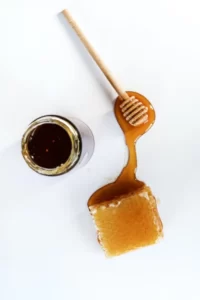Table of Contents
Is Manuka Better Than Other Honey?
Introduction
When it comes to honey, Manuka is often touted as being superior to other varieties. But is this claim based on scientific evidence, or is it just clever marketing? In this article, we will explore the differences between Manuka honey and other types of honey, such as Jarrah honey. We will delve into the science behind both honeys, their medicinal properties, and which one comes out on top. So, let’s dive in and find out if Manuka honey is truly better than other honey.
Manuka Honey vs. Jarrah Honey: The Basics
Manuka honey and Jarrah honey are both classified as medicinal honeys. However, they come from different sources and have distinct properties. Manuka honey is derived from the nectar of the Manuka bush, found in New Zealand and Australia, while Jarrah honey is produced from the nectar of Jarrah trees, which can only be found in Western Australia.
One of the key differences between these honeys lies in their main medicinal property. Manuka honey contains a higher concentration of Methylglyoxal (MGO) than other honeys. MGO is a phytochemical that gives Manuka honey its non-peroxide activity (NPA), which is responsible for its antimicrobial qualities. Jarrah honey, on the other hand, has a unique composition that results in a range of beneficial properties, including low glycemic index (GI), strong prebiotic power, resistance to crystallization, and numerous antioxidant and anti-inflammatory phytochemicals.
Measuring Quality: UMF and JF
The quality of Manuka honey is often measured by its MGO value or the Unique Manuka Factor (UMF). The MGO value can range from 50 to over 500, indicating the level of non-peroxide activity in the honey. The UMF is a proprietary value for the NPA and typically ranges from 5 to 15, with rare instances of up to 25. The higher the MGO value or UMF, the higher the quality of the Manuka honey.
In contrast, the quality of Jarrah honey is measured using Forest Fresh’s proprietary Jarrah Factor (JF). The JF takes into account the unique composition of Jarrah honey and determines its overall quality. It considers factors such as prebiotic power, resistance to crystallization, and the presence of antioxidant and anti-inflammatory phytochemicals.
Antimicrobial Power: NPA and PA
Both Manuka honey and Jarrah honey possess antimicrobial properties. However, the mechanisms behind these properties differ. Manuka honey’s antimicrobial power primarily comes from its non-peroxide activity (NPA), which is derived from the MGO present in the honey. The higher the NPA value, the stronger the antimicrobial activity of the honey.
In contrast, Jarrah honey’s antimicrobial power is predominantly due to its peroxide activity (PA). Peroxide activity is a preservation process developed by bees over millions of years. In most honeys, the residual PA is minimal, but in certain Western Australian honeys, including Jarrah honey, it is exceptionally high. The total activity (TA) value of Jarrah honey, which is the sum of its NPA and PA, is equivalent to the UMF value of Manuka honey.
Conclusion
In conclusion, both Manuka honey and Jarrah honey have their unique properties and medicinal benefits. Manuka honey is known for its high levels of MGO and non-peroxide activity, while Jarrah honey boasts a range of beneficial properties and a strong antimicrobial power due to its peroxide activity. Ultimately, the choice between the two depends on personal preferences and the specific health benefits one is seeking.
It’s important to note that the quality of honey is not solely determined by its activity value. Forest Fresh’s proprietary Jarrah Factor takes into account the composition of Jarrah honey and provides a comprehensive measure of its quality. Regardless of which honey you choose, both Manuka and Jarrah honey can be a valuable addition to a healthy diet and lifestyle.
If you’re interested in learning more about Manuka honey, Jarrah honey, or other types of honey, please visit https://aboutmanukahoney.com for reliable and accurate information.



